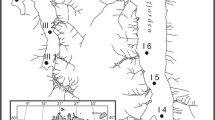Abstract
The Cuyahoga River is a heavily polluted tributary of Lake Erie located in N. E. Ohio (USA).
One hundred seventy taxa of diatoms were identified from seven locations along the Cuyahoga River. The most frequently collected diatoms from each station were Cyclotella meneghiniana, Gomphonema parvulum, Navicula cryptocephala, N. cryptocephala var. veneta, N. lanceolata, N. menisculus, N. minima, N. minuscula, N. pelliculosa, Nitzschia amphibia, N. ovalis, N. palea, and Rhoicosphenia curvata.
In the most heavily damaged region of the river these widely-distributed taxa were the only frequently collected diatoms.
The relatively undamaged section of the river contained 94% more taxa than the most heavily damaged section. Chief among these additional taxa were Achnanthes lanceolata, A. lanceolata var. dubia, Cocconeisplacentula, Fragilaria vaucheriae, Melosira varians, Meridion circulare, Navicula mutica var. tropica, N. symetrica, Nitzschia dissipata, Stephanodiscus astraea, and Synedra rumpens.
The degree of similarity between diatom assemblages along the Cuyahoga River as measured by a modification of Sørensen's index of similarity in species-frequency of occurrence composition was related to the degree of chemical-physical water quality similarities and to the extent of similarity between areas of geologic and biologic substrates. The most dissimilar diatom assemblages usually occurred between locations that were the most dissimilar with respect to chemical-physical water quality conditions rather than to dissimilarities with respect to sediment-substrate composition.
Similar content being viewed by others
References
American Public Health Association. 1971. Standard Methods for the Examination of Water and Wastewater. 13th ed. Amer. Pub. Health Assoc., Washington, D.C. 769 p.
Blum, J. L. 1956. The ecology of river algae. Bot. Rev. 22: 291–341.
Butcher, R. W. 1947. Studies in the ecology of rivers. IV. The algae of organically enriched water. J. Ecol. 35: 186–191.
Cholnoky, B. J. 1968. Die Ökologie der Diatomeen in Binnengewässern. J. Cramer, Lehre. 699 p.
Collins, G. B. & Kalinsky, R. G. 1977. Studies on Ohio Diatoms: I. Diatoms of the Scioto River basin. II. Checklist of diatoms from Ohio exclusive of Lake Erie and the Ohio River. Bulletin of the Ohio Biological Survey N. S. 5 (3). The Ohio State Univ. Press, Columbus, Ohio. (in press).
Douglas, B. 1958. The ecology of attached diatoms and other algae in a small stony creek. J. Ecol. 46: 295–322.
Duncan, D. B. 1955. Multiple range and multiple F tests. Biometrics 11: 1–42.
Harter, H. L. 1960. Critical values for Duncan's new multiple-range test. Biometrics 16: 671–685.
Hohn, M. H. & Hellerman, J. 1963. The taxonomy and structure of diatom populations from three eastern North American rivers using three sampling methods. Trans. Amer. Microscop. Soc. 82: 250–329.
Hufford, T. L. & Collins, G. B. 1976. Distribution patterns of diatoms in Cedar Run. Ohio J. Sci. 76 (4): 172–184.
Hustedt, F. 1957. Die Diatomeenflora des Flussystems der Weser in Gebiet der Hamsestadt Bremen. Abhandl. Naturwiss. Ver. Bremen. (Bremen) 34: 181–440.
Hynes, H. B. N. 1970. The Ecology of Running Waters. University of Toronto Press, Toronto, Canada. 555 p.
Jørgensen, E. G. 1952. Notes on the ecology of the diatom Navicula accomoda Hustedt. Svensk Bot. Tidskr. (Uppsala) 49: 189–191.
Lowe, R. L. 1974. Environmental requirements and pollution tolerance of freshwater diatoms. Nation. Env. Res. Ctr. U. S. Env. Prot. Agency, Cincinnati, Ohio (USA). 334 p.
Lowe, R. L. & McCullough, J. M. 1974. The effect of sewagetreatment plant effluent on diatom communities in the North Branch of the Portage River, Wood County, Ohio. Ohio J. Sci. 74: 154–161.
Moore, J. W. 1972. Composition and structure of algal communities in a tributary stream of Lake Ontario. Can. J. Bot. 50: 1663–74.
National Technical Advisory Committee. 1968. Water Quality Criteria. Report to the Secretary of the Interior. Fed. Water Poll. Control Administration (U. S. Env. Prot. Agency). Washington, D.C. 234 p.
Olive, J. H. 1976. Chemical-physical and biological assessment of water quality in the Cuyahoga River (1973–1974). Ohio J. Sci. 76 (1): 5–15.
Patrick, R. 1948. Factors effecting the distribution of diatoms. The Bot. Rev. 14 (8): 473–524.
Patrick, R. 1964. A discussion of natural and abnormal diatom communities, p. 185–204. In Algae and Man, D. F. Jackson (ed.). Plenum Press, N. Y. 434 p.
Patrick, R. & Reimer, C. W. 1966. The Diatoms of the United States. Vol. I. Acad. Nat. Sci. Philadelphia. 688 p.
Pryfogle, P. A. 1975. Seasonal distribution of periphytic diatom communities of Tymochtee Creek, p. 154–173. In Proceedings Sandusky River Basin Symposium. International Joint Commission. Canada-U.S.A. Great Lakes Water Quality Agreement 1972. 475 p.
Round, F. E. 1964. The ecology 0f benthic algae, p. 138–184. In Algae and Man, D. F. Jackson (ed.). Plenum Press, New York. 434 p.
Round, F. E. 1965. The application of diatom ecology to water pollution and purification. p. 29–33. In C. M. Tarzwell, (ed.) Biological Problems in Water Pollution, third seminar, 1962. U. S. Public Health Service Publ. No. 999-WP-25, 424 p.
Sørensen, T. 1948. A method of establishing groups of equal amplitude in plant society based on similarity of species content. K. Danske Vidensk., 5: 1–34.
Sreenivasa, M. R. & Duthie, H. C. 1973. Diatom flora of the Grand River, Ontario, Canada. Hydrobiologia 42 (2–3): 162–224.
U.S. Geological Survey. 1973–74. Water Resources Data for Ohio. Water Resources Division, U. S. Geological Survey. Columbus, Ohio.
Author information
Authors and Affiliations
Rights and permissions
About this article
Cite this article
Olive, J.H., Price, J.L. Diatom assemblages of the Cuyahoga river, N. E. Ohio (USA). Hydrobiologia 57, 175–187 (1978). https://doi.org/10.1007/BF00016462
Received:
Published:
Issue Date:
DOI: https://doi.org/10.1007/BF00016462




